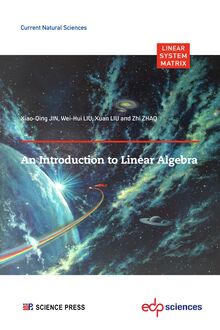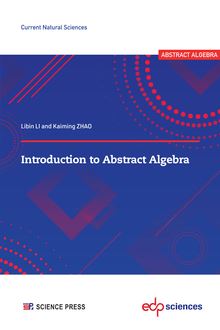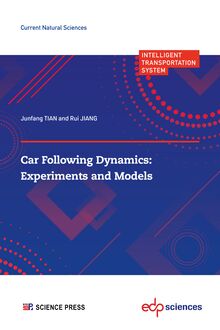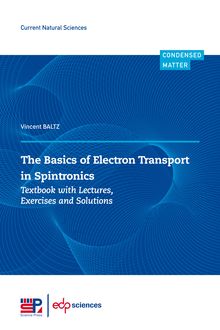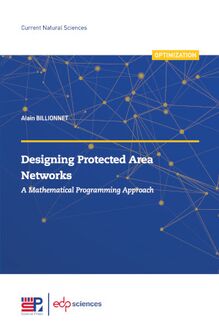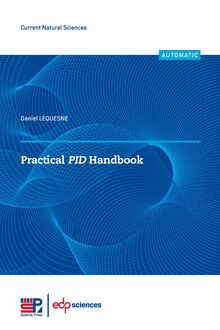Solutions to Linear Matrix Equations and Their Applications , livre ebook
198
pages
English
Ebooks
2023
Obtenez un accès à la bibliothèque pour le consulter en ligne En savoir plus
Découvre YouScribe et accède à tout notre catalogue !
Découvre YouScribe et accède à tout notre catalogue !
198
pages
English
Ebooks
2023
Obtenez un accès à la bibliothèque pour le consulter en ligne En savoir plus
Publié par
Date de parution
20 juillet 2023
Nombre de lectures
2
EAN13
9782759831036
Langue
English
Poids de l'ouvrage
2 Mo
This book addresses both the basic and applied aspects of the finite iterative algorithm, CGLS iterative algorithm, and explicit algorithm to some linear matrix equations. The author presents the latest results in three parts: (1) We consider the finite iterative algorithm to the coupled transpose matrix equations and the coupled operator matrix equations with sub-matrix constrained. These two finite iterative algorithms are closely related and progressive. (2) We present MCGLS iterative algorithm for studying least squares problems to the generalized Sylvester-conjugate matrix equation, the generalized Sylvester-conjugate transpose matrix equation, and the coupled linear operator systems, respectively. (3) Compared with the previous two parts, we consider here the explicit solution to some linear matrix equations, which are the nonhomogeneous Yakubovich matrix equation, the nonhomogeneous Yakubovich transpose matrix equation, and the generalized Sylvester matrix equation, respectively. This book is intended for students, researchers, and professionals in the field of numerical algebra, linear matrix equations, nonlinear matrix equations, and control theory.
About the Author ............................................ III
Preface..................................................... V
Notations................................................... VII
CHAPTER 1
Introduction................................................. 1
1.1 The First Part: Finite Iterative Algorithm to Linear Matrix Equation . 1
1.2 The Second Part: MCGLS Iterative Algorithm to Linear Matrix Equation............................................... 3
1.3 The Third Part: Explicit Solutions to Linear Matrix Equation ...... 5
CHAPTER 2
Finite Iterative Algorithm to Coupled Transpose Matrix Equations ....... 11
2.1 Finite Iterative Algorithm and Convergence Analysis ............. 12
2.2 Numerical Example ....................................... 24
2.3 Control Application ...................................... 27
2.4 Conclusions............................................. 28
CHAPTER 3
Finite Iterative Algorithm to Coupled Operator Matrix Equations withSub-Matrix Constrained .................................... 29
3.1Iterative Method for Solving Problem 3.1 ...................... 30
3.2Iterative Method for Solving Problem 3.2 ...................... 41
3.3 Numerical Example ....................................... 42
3.4 Control Application ...................................... 53
3.5 Conclusions............................................. 54
CHAPTER 4
MCGLSIterative Algorithm to Linear Conjugate Matrix Equation ........ 55
4.1 MCGL SIterative Algorithm and Convergence Analysis............ 57
4.2 Numerical Example ....................................... 66
4.3 ControlApplication ...................................... 73
4.4 Conclusions............................................. 74
CHAPTER 5
MCGLS Iterative Algorithm to Linear Conjugate Transpose Matrix Equation................................................... 75
5.1 MCGLS Iterative Algorithm and Convergence Analysis............ 78
5.2 Numerical Example ....................................... 90
5.3 Conclusions............................................. 95
CHAPTER 6
MCGLS Iterative Algorithm to Coupled Linear Operator Systems ........ 97
6.1 Some Useful Lemmas ..................................... 98
6.2 MCGLS Iterative Algorithm and Convergence Analysis............ 99
6.3 Numerical Examples ...................................... 107
6.4 Conclusions............................................. 113
CHAPTER 7
Explicit Solutions to the Matrix Equation X − AXB = CY + R .......... 115
7.1 Solutions to the Real Matrix Equation X − AXB = CY + R ....... 115
7.2 Parametric Pole Assignment for Descriptor Linear Systems by P-DFeedback ........................................ 124
7.3 Conclusions............................................. 128
CHAPTER 8
Explicit Solutions to the Non homogeneous Yakubovich-Transpose Matrix Equation................................................... 131
8.1 The First Approach ...................................... 132
8.2 The Second Approach ..................................... 140
8.3 Illustrative Example ...................................... 142
8.4 Conclusions............................................. 143
CHAPTER 9
Explicit Solutions to the Matrix Equations XB-AX = CY.......................................... 145
9.1 Real Matrix Equation XB − AX = CY and XB - AX = CY ........................ 145
9.2 Quaternion-j-Conjugate Matrix Equation XB − AX = CY......... 148
9.2.1 Real Representation of a Quaternion Matrix .............. 148
9.2.2 Solutions to the Quaternion j-Conjugate Matrix Equation XB − AX =CY ................................... 150
9.3 Conclusions............................................. 155
CHAPTER 10
Explicit Solutions to Linear Transpose Matrix Equation ................ 157
10.1Solutions to the Sylvester Transpose Matrix Equation ............ 157
10.1.1 The First Case: A or B is Nonsingular ................. 158
10.1.2 The Second Case: A and B are Nonsingular ............. 162
10.2 Solutions to the Generalized Sylvester Transpose Matrix Equation . . 165
10.3 Algorithms for Solving Two Transpose Equations and Numerical Example.............................................. 168
10.4 Application in Control Theory ............................. 174
10.5 Conclusions ............................................ 175
References.................................................. 177
Publié par
Date de parution
20 juillet 2023
EAN13
9782759831036
Langue
English
Poids de l'ouvrage
2 Mo
Current Natural Sciences
Caiqin SONG
LINEAR
ALGEBRA
Solutions to Linear Matrix
Equations andTheir Applications
LINEAR
ALGEBRA
ISBN : 978-2-7598-3102-9
Current Natural Sciences
Solutions to Linear Matrix
Equations and Their Applications
Caiqin SONG
This book addresses both the basic and applied aspects of the
finite iterative algorithm, CGLS iterative algorithm, and explicit
algorithm to some linear matrix equations. The author presents
the latest results in three parts:
(1) We consider the finite iterative algorithm to the coupled
transpose matrix equations and the coupled operator matrix
equations with sub-matrix constrained. These two finite iterative
algorithms are closely related and progressive.
(2) We present MCGLS iterative algorithm for studying least
squares problems to the generalized Sylvester-conjugate matrix
equation, the generalized Sylvester-conjugate transpose matrix
equation, and the coupled linear operator systems, respectively.
(3) Compared with the previous two parts, we consider here
the explicit solution to some linear matrix equations, which
are the nonhomogeneous Yakubovich matrix equation, the
nonhomogeneous Yakubovich transpose matrix equation, and
the generalized Sylvester matrix equation, respectively.
This book is intended for students, researchers, and professionals
in the field of numerical algebra, linear matrix equations, nonlinear
matrix equations, and control theory.
Caiqin SONGis an associate professor at University of Jinan.
She received her PhD from East China Normal University in 2012.
Her research focuses on the explicit method of linear matrix
equations, the iterative algorithm of linear matrix equations, the
explicit method of quaternion matrix equations, and problems on
the semi-tensor product of matrix, etc. She is the author of more
than 30 publications in international academic journals and has
chaired national and provincial commissions of research funding
programs.
www.edpsciences.org
Current Natural Sciences
Caiqin SONG
Solutions to Linear
Matrix Equations and
Their Applications
Printed in France
EDP Sciences–ISBN(print): 978-2-7598-3102-9–ISBN(ebook): 978-2-7598-3103-6
DOI: 10.1051/978-2-7598-3102-9
All rights relative to translation, adaptation and reproduction by any means whatsoever
are reserved, worldwide. In accordance with the terms of paragraphs 2 and 3 of Article 41
of the French Act dated March 11, 1957,“copies or reproductions reserved strictly for
private use and not intended for collective use”and, on the other hand, analyses and
short quotations for example or illustrative purposes, are allowed. Otherwise,“any
representation or reproduction–whether in full or in part–without the consent of the
author or of his successors or assigns, is unlawful”(Article 40, paragraph 1). Any
representation or reproduction, by any means whatsoever, will therefore be deemed an
infringement of copyright punishable under Articles 425 and following of the French
Penal Code.
The printed edition is not for sale in Chinese mainland. Customers in Chinese mainland
please order the print book from Science Press. ISBN of the China edition: Science Press
978-7-03-072138-9
Science Press, EDP Sciences, 2023
About
the
Author
Caiqin Song, now is an associate professor and Master’s supervisor. She received her
PhD from East China Normal University in June 2012. The main research direction
is the explicit method of linear matrix equations, the iterative algorithm of linear
matrix equations, the explicit method of quaternion matrix equations, and the
problem of the semi-tensor product of matrix, etc. She has published more than 30
academic papers in international academic journals. She once presided over one
National Natural Science Foundation of China (No. 11501246), one first-class grant
and one second-class grant from the China Postdoctoral Science Foundation
(No. 2017M610243, 2013M541900), and one Shandong Provincial Natural Science
Foundation (No. ZR2020MA052).
Preface
Solving linear matrix equations has experienced decades of development and has
become a relatively mature scientific field. The study of linear matrix equations
needs to focus on two important elements: one is the sufficient condition or necessary
and sufficient condition of the linear matrix equation having a solution; the other is
the explicit solution expression or iterative algorithm formula. The topic on linear
matrix equations includes the solvable conditions of linear matrix equations, mainly
including sufficient conditions and necessary and sufficient conditions; explicit
method of linear matrix equations; iterative algorithms of linear matrix equations
and comparison with various types of existing algorithms in time and accuracy; the
application of linear matrix equation in the field of control. The knowledge of linear
matrix equations is becoming more and more necessary. It has been applied in many
engineering branches, such as robust control, observer design, and attitude control of
spacecraft.
This book is written for a wider audience and has three main purposes. Firstly, for
researchers who want to consider the linear matrix equation, but lack of the
knowledge about linear matrix equations. In this case, this book can be used as a
primer book. Secondly, this book can provide its control model for researchers who
have many important and good research results in the field of the linear matrix
equation. Thirdly, this book provides textbooks or reference books for graduate
students in related fields. In order to achieve the above purpose, this book provides
two types of iterative algorithms for some linear matrix equations, which are used to
find the numerical solutions and least squares solutions of several types of linear
matrix equations, and provides an explicit method for several types of linear matrix
equations.
This book has several characteristics: Firstly, the book contains a number of
recent research results, giving a finite iterative algorithm for coupled operator
matrix equations with sub-matrix constraints and a least squares iterative algorithm
for coupled operator matrix equations. Secondly, the control model and the
application of the algorithm to the linear matrix equation are given. The iterative
DOI: 10.1051/978-2-7598-3102-9.c901
Science Press, EDP Sciences, 2023
VI
Preface
algorithms and explicit solutions provided in this book are very useful for further
research on control problems. This book is not only easy to understand, but also
provides a large number of cybernetic models and numerical examples to illustrate
the superiority and practicality of the algorithm.
Caiqin SONG
July 29, 2021
Notations
C:the set of all complex numbers
R:the set of all real numbers
mn
R:the set of all the real matrixmn
mn
C:the set of all the complex matrixmn
A:the conjugate of matrixA
T
the transpose of matrixA
A:
A:the conjugate transpose of matrixA
1
the inverse of matrixA
A:
In:the identity matrix withnn
0mn:the zero matrix withmn
detðAÞ:the determinant of matrixA
rðAÞ:the rank of matrixA
trðAÞ:the trace of matrixA
qðAÞ:the spectral radius of matrixA
kðAÞ:the set of character value on matrixA
kxk:Euclid length of vectorx
2
kAk:the spectral norm of matrixA
2
kAk:the Frobenius norm of matrixA
F
AB:representsAandBwith same size satisfyingaijbij
[:Collective union
\:Collection of crosses
;set: empty
():equivalence
ai:theith column ofA
T
T TT
the vec operator of matrixA
vecðAÞ ¼ ða;a;. . .;aÞ:
1 2n
hA;Bi:the inner product of matricesAandB
mn;pq mn pq
LC:the set of linear operators fromContoC
mn
I:the identity operator onC
I½1;N:the integer set from 1 toN
Contents
About the Author. . . . . . . . . . . . . . . . . . . . . . . . . . . . . . . . . . . . . . . . . . . .
Preface. . . . . . . . . . . . . . . . . . . . . . . . . . . . . . . . . . . . . . . . . . . . . . . . . . . . .
Notations. . . . . . . . . . . . . . . . . . . . . . . . . . . . . . . . . . . . . . . . . . . . . . . . . . .
CHAPTER 1
Introduction. . . . . . . . . . . . . . . . . . . . . . . . . . . . . . . . . . . . . . . . . . . . . . . . .
1.1 TheFirst Part: Finite Iterative Algorithm to Linear Matrix Equation.
1.2 TheSecond Part: MCGLS Iterative Algorithm to Linear Matrix
Equation. . . . . . . . . . . . . . . . . . . . . . . . . . . . . . . . . . . . . . . . . . . . . . .
1.3 TheThird Part: Explicit Solutions to Linear Matrix Equation. . . . . .
CHAPTER 2
Finite Iterative Algorithm to Coupled Transpose Matrix Equations. . . . . . .
2.1 FiniteIterative Algorithm and Convergence Analysis. . . . . . . . . . . . .
2.2 NumericalExample. . . . . . . . . . . . . . . . . . . . . . . . . . . . . . . . . . . . . . .
2.3 ControlApplication. . . . . . . . . . . . . . . . . . . . . . . . . . . . . . . . . . . . . .
2.4 Conclusions. . . . . . . . . . . . . . . . . . . . . . . . . . . . . . . . . . . . . . . . . . . . .
CHAPTER 3
Finite Iterative Algorithm to Coupled Operator Matrix Equations
with Sub-Matrix Constrained. . . . . . . . . . . . . . . . . . . . . . . . . . . . . . . . . . . .
3.1 IterativeMethod for Solving Problem 3.1. . . . . . . . . . . . . . . . . . . . . .
3.2 IterativeMethod for Solving Problem 3.2. . . . . . . . . . . . . . . . . . . . . .
3.3 NumericalExample. . . . . . . . . . . . . . . . . . . . . . . . . . . . . . . . . . . . . . .
3.4 ControlApplication. . . . . . . . . . . . . . . . . . . . . . . . . . . . . . . . . . . . . .
3.5 Conclusions. . . . . . . . . . . . . . . . . . . . . . . . . . . . . . . . . . . . . . . . . . . . .
CHAPTER 4
MCGLS Iterative Algorithm to Linear Conjugate Matrix Equation. . . . . . . .
4.1 MCGLSIterative Algorithm and Convergence Analysis. . . . . . . . . . . .
4.2 NumericalExample. . . . . . . . . . . . . . . . . . . . . . . . . . . . . . . . . . . . . . .
4.3 ControlApplication. . . . . . . . . . . . . . . . . . . . . . . . . . . . . . . . . . . . . .
4

